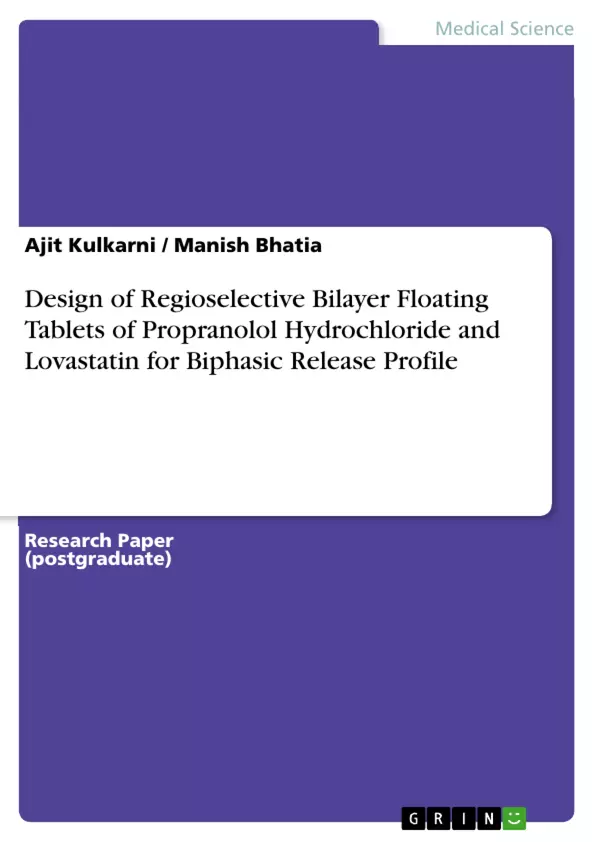The purpose of the study was to design bilayer floating tablets of Propranolol hydrochloride and Lovastatin to give immediate release of Lovastatin and controlled release of Propranolol hydrochloride. Bilayer floating tablets comprised of two layers, immediate release layer and controlled release layer. Direct compression method was employed for formulation of the bilayer tablets. Short term accelerated stability studies were carried out on the prepared tablets. All the formulations floated for more than 12h. More than 90% Lovastatin was released within 30 min. from the formulations. HPMC K4M and Xanthan gum retarded the release of Propranolol hydrochloride from the controlled release layer for 12h. After stability studies, apparent degradation of both the drugs were found but the drug content was found to be within the range. Diffusion exponent (n) was determined for all the formulations (0.53-7). Based on coefficient of correlation(R), the release of Propranolol hydrochloride was found to follow mixed release pattern of Hixson-Crowell, Korsmeyer-Peppas and matrix, except formulation F6 and F9, which followed zero order release pattern. Statistical analysis revealed that there was no significant difference in in vitro release pattern of the drugs before and after stability studies.
Inhaltsverzeichnis (Table of Contents)
- ABSTRACT
- INTRODUCTION
- MATERIALS AND METHODS
- Propranolol hydrochloride
- Lovastatin
- HPMC K4M and Xanthan gum(XG)
- Sodium starch glycolate(SSG)
- Tablettose 80
- Magnesium stearate(Loba chemicals, Mumbai, India)
- di-calcium phosphate(S.D.Fine chemicals, Mumbai, India)
- Sodium bi carbonate(Research lab, Mumbai, India)
- Method
- Preparation of Bilayer Floating Tablets
- Preparation of controlled release layer
- Preparation of immediate release layer
- Floating characteristics
- Drug content
- Propranolol HCI
- Lovastatin
Zielsetzung und Themenschwerpunkte (Objectives and Key Themes)
The study's objective was to develop bilayer floating tablets of Propranolol hydrochloride and Lovastatin, aiming for immediate release of Lovastatin and controlled release of Propranolol hydrochloride. The research focused on using direct compression techniques for formulating the bilayer tablets. The study also investigated the stability and release kinetics of the drugs, exploring the potential for controlled drug release in the gastrointestinal tract.
- Design of bilayer floating tablets for biphasic drug release
- Investigation of drug release profiles and stability of the formulated tablets
- Evaluation of floating characteristics and in vitro drug release studies
- Analysis of drug content and physicochemical properties
- Application of different mathematical models to assess the release kinetics of Propranolol hydrochloride
Zusammenfassung der Kapitel (Chapter Summaries)
The introduction section sets the context for the research by discussing the prevalence of hypertension and hypercholesterolemia and the need for combined drug therapy. It highlights the advantages of using gastroretentive dosage forms, specifically focusing on floating tablets. The study aims to develop a bilayer floating tablet formulation for the simultaneous delivery of Lovastatin and Propranolol hydrochloride, aiming for different release profiles for each drug. The materials and methods section provides a detailed account of the materials used in the study and the methodology employed for the preparation of bilayer floating tablets. This includes the direct compression method, the use of specific excipients for controlled drug release, and the techniques for evaluating the physical and chemical properties of the prepared tablets. The floating characteristics and drug content of the tablets are assessed using various methods, providing comprehensive data on the performance of the formulation.
Schlüsselwörter (Keywords)
The research focuses on the development and evaluation of bilayer floating tablets for the controlled release of Propranolol hydrochloride and Lovastatin. The keywords encompass important themes such as controlled release, gastroretentive drug delivery, floating tablets, bilayer formulation, Lovastatin, Propranolol hydrochloride, and in vitro drug release studies.
- Arbeit zitieren
- Ph.D. Ajit Kulkarni (Autor:in), Manish Bhatia (Autor:in), 2014, Design of Regioselective Bilayer Floating Tablets of Propranolol Hydrochloride and Lovastatin for Biphasic Release Profile, München, GRIN Verlag, https://www.grin.com/document/284893



